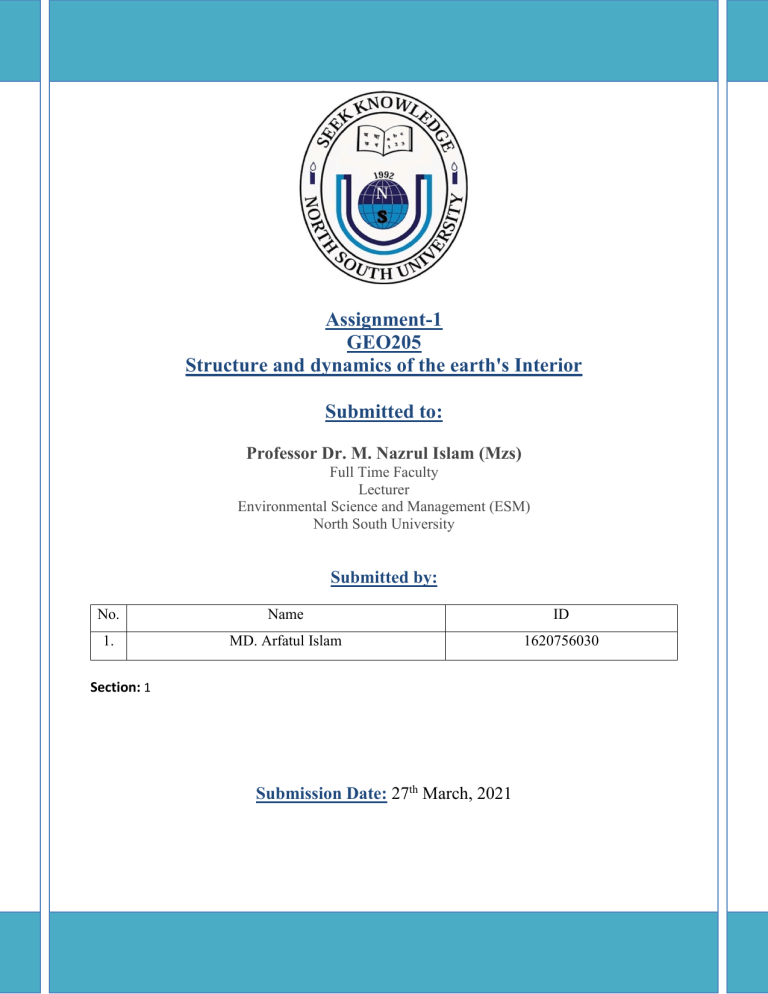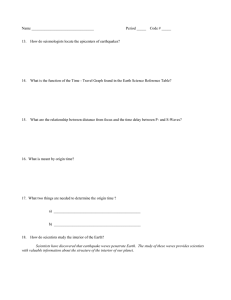Assignment-1 GEO205 Md. Arfatul Islam 1620756030-converted
advertisement

Assignment-1 GEO205 Structure and dynamics of the earth's Interior Submitted to: Professor Dr. M. Nazrul Islam (Mzs) Full Time Faculty Lecturer Environmental Science and Management (ESM) North South University Submitted by: No. Name ID 1. MD. Arfatul Islam 1620756030 Section: 1 Submission Date: 27th March, 2021 1|Page Table of Contents: Content Page Number Introduction 2 Observing the Earth’s surface 3 Earth’s Four Spheres 4 INTERATIONS BETWEEN THE 4 7,8 SPHERES Earth Layers 8 The Crust 9 The Mantle The core 11,12 13,14,15 Conclusion 16 References 17 2|Page Introduction: The inside of the earth, as depicted on the cover, can be represented as a collection of concentric shells. Since the time of Isaac Newton, who noticed in a discussion of the planets that the average density of the earth is five to six times that of water, scientists have recognized that the earth is not a homogeneous, structureless body. The planet's average density is 5.5 g per em3 (grams per cubic centimeter), and because the average density of surface rocks is only around 2.8 g per em3, there must be a significant amount of higher density material within the earth. We can deduce from this and other evidence that the planet has a dense core. Indeed, geophysicists and geologists have calculated over the last 60 years that the thickness and character of each successive layer in the earth, including differences within certain layers, have been determined with growing certainty. Man has actually looked through the earth in deep mines and dug holes for just about 5 miles of the 4,000-mile distance to the earth's core. Furthermore, since man would almost certainly never be able to drill a hole into the deep interior, what we know about it must be based on indirect facts. At the moment, this proof consists of (1) direct measurements of rocks on the surface, (2) secondary observations focused on geophysical processes (including vibrations across the atmosphere from earthquakes and explosive causes, and celestial movements of the earth). flow of heat from the interior, magnetic field, and gravitational attraction), (3) laboratory experiments on surface rocks and minerals, and (4) contrast of the earth with the other planets, the sun, stars, and meteorites, which may be parts of a disintegrated former world. 3|Page Observing the Earth’s surface The atmosphere and hydrosphere come into contact with rocks and minerals on Earth's surface, where rocks respond to our planet's environments on their own. The Earth's surface is constantly changing and changing over time, resulting in a variety of ecosystems. A landscape's elements vary from soil composition (grasslands and mountains) to water sources (lakes, rivers, and waterfalls), wildlife (fauna), plants (flora), climate, and man's works (cities, roads, castles and many infrastructures). A natural landscape, without human interference, is often the product of two conflicting forces, a war that has waged for thousands of years between the geological cycles that exist within the Earth (the displacement of earth plates, seismic activity, etc.) and the forces of nature. processes that result in the formation of new mountains) and processes that exist outside of the Earth's crust (erosion and water transport of material, changes due to particular climate conditions and many others). 4|Page Earth’s Four Spheres: All in the Earth's environment can be separated into four main subsystems: soil, water, living beings, and air. These four subsystems are referred to as "spheres." They are the "lithosphere" (land), the "hydrosphere" (water), the "biosphere" (living things), and the "atmosphere" (air). Each of these four spheres is subdivided into sub-spheres. The Biosphere— includes all the living organisms on the earth. This area encompasses all the Earth's microorganisms, plants and animals. In the biosphere, living organisms create ecological ecosystems dependent on an area's physical environment. These groups are known as biomes. Deserts, grasslands and rainforests are three of the very distinct biomes within the biosphere. The following can be listed as the most outstanding characteristics of the biosphere: ➢ Life is primarily developed on the surface layer of the soil in the biosphere. ➢ The main source of electricity is solar energy. ➢ It is habitats that function all of it. ➢ It is around 20 kilometers thin layer. ➢ It has a great deal that belongs to ecosystems and has many other non-living components. The Lithosphere—contains all of the colder, robust soil of the atmosphere of the earth, the semi-solid soil beneath the crust, and the fluid soil next to the planet's core. The lithosphere surface is extremely irregular. There are high mountain range such as the rocks and Andes, vast plains or flat plains such as Texas, Iowa and Brazil, and deep ocean-floor valleys. 5|Page The lithosphere's solid, semi-solid, and liquid soil form biologically and chemically complex layers. Would someone cut Earth into its center, these layers would be exposed as onion layers. The external layer of the lithosphere is composed of nitrogen-, oxygen- and silicon-rich loose rock. Underneath this layer there is a very thin, stable oxygen and silicone crust. The next thing is an oxygen, rubber, iron and magnesium mantle, heavy and semi social. Below is the external nickel and iron liquid nucleus. A solid inner core of nickel and iron is in the middle of the Earth. The planet consisting of the crust and part of the ground mantle, three separate layers, just two of which pertain to the lithosphere: Crust: consists of basalt and granite rocks. It has geographical characteristics, such as valleys, mountains, plains and so on, that are visible. In continental masses it is also present Mantle: the mantle contains various elements such as magnesium, iron, calcium and silicates of aluminum. The coat is separated into two layers, top and bottom, which are responsible for the tectonic plate. Core: The core is broken into a cast iron outer core. The inner core is circled and strong in nature by the outside core. The Hydrosphere — comprises the whole of the planet's solid, liquid and gaseous water. The thickness varies from 10 and 20 kilometers. The hydrosphere reaches down several kilometers from the Earth's crust into the lithosphere and up into the atmosphere for about 12 kilometres. A tiny part of the water is cool in the water (non-salty). This water flows from the atmosphere to the surface of the planet, as rivers and rivers running along the surface of the earth, and as groundwater under the surface of the earth. All the fresh water on Earth is mostly frozen. 6|Page Earth's water is acidic at 97 percent. Salty waters gather around the top of Earth in deep valleys. This large saline water collections are known as the oceans. The picture above shows various temperatures found on the surfaces of the oceans. Water is very cold at the poles while water is very warm at the equator. The temperature variations allow water to change physical conditions. Extraordinarily small temperatures such as those observed at the poles freeze water in a solid, such as a polar icecap, glacier or iceberg. Very hot temperatures like those seen on the equator are causing a gas evaporation of water. The hydrosphere's core characteristics are: ➢ That is the surrounding layer of the earth. ➢ It is constantly altering the physical condition of the water in it. ➢ She wants the sun to adjust the state of the bath. ➢ Seas are 35 gr/l salinity. ➢ The temperature can vary according to depth and latitude. ➢ It depends on the salinity of its density. ➢ The water gasses are the same as the air gasses are there. Atmosphere – the Earth's environment comprises all the air. It ranges from less than 1 m below the surface of the earth to over 10,000 km across the surface of the planet. The atmosphere's upper section preserves the biosphere's organisms from ultraviolet radiation. It also absorbs and heats 7|Page up. The atmosphere happens as the air temperature in the lower part of this region increases. When air is heated or cooled down in the atmosphere, it travels around the earth. The effect is plain or complicated like a wind or hurricane. INTERATIONS BETWEEN THE 4 SPHERES Although the four structures have individual personalities, the interactions between them are essential. The impact of activities in one sphere on the next was studied by environmental science. The Earth system may have 10 potential modes of interaction. Four of these connections are between each of the events. The spheres on earth. The double-headed arrows show that the relations of cause and effect of such encounters are directed in both directions. Figure #1 demonstrates these four forms of connections. The event "<>hydrosphere" refers to the hydrosphere consequences of the event and the event effects of the hydrosphere. For example, a volcanic eruption can have dramatic consequences on the hydrosphere, the atmosphere and biosphere directly and indirectly. 8|Page For example: Example: (Volcano) Mount Saint Helens, Washington State, erupted on 18 May 1980. This occurrence has altered the climate and allowed scientists to research the impact of volcanic eruptions on the lithosphere, hydrosphere, environment and biosphere. This studies are significant because volcanic eruptions continue to occur and are affecting people increasingly, as people continue to occupy land closer to sleeping volcanoes. Earth layers: The Earth is not a solid sphere. It is made of four major layers. ➢ Crust ➢ Mantle ➢ Outer Core ➢ Inner Core 9|Page THE CRUST: Earthquakes and the Earth's Crust- When we recall that a great thickness of sedimentary rocks has grown to shape the Himalayan Mountain 6 miles above sea level, we are mindful that there are enormous forces in the earth to raise the crust up and down laterally. Local heat sources deep inside the earth are supposed to provide electricity for building mountains and lower basins. The surface manifestations of mechanical energy release from mountain construction and other earthquakes are earthquakes. Geologists locate the faults (fractures) or foldings (plastic turns) that show mechanical deformation of the cliffs in mountain buildings by mapping the rocks on the earth's surface. Sudden rocks on either side of a fault produce an earthquake called an earthquake, and earthquakes are also caused under volcanoes rock. The combination of faults with earthquakes is a historical record for faults in San Andreas along the California coast and in Chile, Turkey and elsewhere. The violent breakup of the rock creates shocks and waves of motion scattered around the universe, much like the waves formed by a pool, as a stone is thrown into it. The waves of the Earthquake are of two forms, (1) the waves of compression, the P of strong particles moving back and forth and the S of the waves running parallel to the direction of moving and the S of the S of the waves, the S of the movement of the particles, transverse to the direction of motion. Earthquake-controlled waves are of two distinct kinds, (1) compressory waves, P with movement in the reverse and reverse direction, and (2) sheer waves, S with particle movement in the reverse, transversal direction of the movement. Earthquake waves are of the following types. Geo physically, the earthquake waves research the speed and directions to discover more about the 10 | P a g e interior of the Earth. One of them, a Yugoslav called Mohorovicic, found a discontinuity in 1909 between what we are now calling the crust and mantle by watching sharpsly the rate of earthquake waves from crown to mantle rise. The discontinuity was named after him; often it is called M discontinuity, or more concurrently "Moho;" the hole that is proposed was called the "Moho," a mole. Oceanic and Continental Crust- The surface of the Earth is about 5 miles deep, sometimes beneath ocean and about 30 miles below high mountains; as shown on the cover, it forms a thin skin around the Planet. Underneath is the mantle's thick shell. The cross sections of figures 5 and 6, which are seen in a scale ten times smaller than the previous figure, indicate oceanic and continental crustacean thickness and topography. These estimates with a horizontal and vertical scale are not as remarkable when compared to the thickness and lateral scaled of the earth's crust below, the craggy slopes of California's Mount Whitney and Hawaiian's Mauna Loan are equal. Compared to the thickness of 34-mile under the Sierra Nevada, relatively large crust thicknesses are typical to mountain areas and are much higher than that of a 4-mile crost (water covers 2y2 miles) at the Mohole site. We assume the continental crust contains mostly (1) thick and lightly coloured igneous rocks, as diorite granite or quartz, at the upper part and (2) basalt, and (commonly erupted from volcanoes) dark and marginally denser igneous rock at the lower part. The oceanic crust nearly completely consists of basalt. The relative thicknesses of the likely rocks in four ocean 11 | P a g e and continental areas. Notice that both the texture and thickness of the crust differ side by side, and not just an even, smooth layer. from the Mohole, we will learn about the origin and history of life, of the oceans, and of the earth itself. The Mantle: Made out of rocky silicate matter, the mantel sits between the Earth's crust and upper core, having an average thickness of 2,886 kilometres, 793 mi. 84% of the world is covered by a mantle in volume versus 15% in the core and the rest is covered by a crow. While mainly solid, it acts as a viscous fluid because of the fact that temperatures are near the point of melting. Our knowledge of the upper mantle, including tectonic plates, derives from seismic waves analyses; heat flow tests and magnet and gravitational studies, and rock and mineral lab experiments. The rock's temperature is close to the freezing point, about 100 and 200 kilometers below the surface of the earth; molten rock expelled by some volcanoes originated in this part of the mantle. Structure and composition- The coat is split into parts based on seismological findings. This is the upper mantle, which ranges from about 7 to 35 km (4.3 to 21.7 mi), down to a depth of 410 km, the transition area from 410 to 660 km (250 to 410 mi) and the lower mantle, from 660 to 2,891, as well as the core-mantling border, which is variable (~200 km or 120 mi average). This is 12 | P a g e also the transition zone which covers the surface area from about 410 to 360 miles, which extends from 410 to 410 mi. Two major areas are differentiated in the upper mantle. The innermost one is the inner asthenosphere, which consists on average of around 200 km (120 mi) thick plastic flowing rock. The exterior field is the lowest. The upper portion of the lithospher is the Earth's crust, a dense 5 to 75 km (3.1 to 46.6 mi) thin layer, which, with the discontinuity of the Mohorovic (or the Moho), is characterized by a sharp rise in the incidence of earthquake waves, separates the mantle. The mantle is exposed in some areas beneath the ocean. There still exist some areas where tectonic activities have moved mantle rock to the surface, particularly the Gros Morne National Park Tablelands in Newfoundland and Labrador, Canada, St John's Island, Egypt and Zabargad Island on the Red Sea. The mantle comprises 44.8% oxygen, 21.5% silicone and 22.8% magnesium in terms of its constituents. Iron, aluminum, calcium, sodium, potassium are all available. All these elements are bound together as silicate rocks, all formed like oxides. Silicon dioxide (SiO2) is most commonly considered to be 48%, followed by magnesium oxide. 13 | P a g e The Core: The earth's centre is below the mantle, found by R. D. Oldham in 1906 in an earthquake record analysis. Kernel is meant to be liquid because it does not transmit shear waves (8), and because it decreases the speed of compressive waves considerably (P). The two earthquake waves pass across the earth (the P, and '8 waves.) The inner core discovered by Miss I. Lehmann in 1936 is called strong by its higher P-wave velocity. The nucleus, on the other hand, is only 15% of Earth's volume but, on the other hand, the core takes up 84%. The core has the same size. The majority is 1 percent of the crust. The P-wave velocity as well as the density at the external border of the nucleus, as seen in Figure 10. These striking property changes occur within a small boundary region, maybe less than 10 miles deep, between the mantle and the core. It is evident that the mantle and the core are markedly compositional. 14 | P a g e The outer core- The exterior core of the earth is a fluid layer about 2,400 kilometers thick, consisting mostly of iron and nickel, above and under the stable inner core of the earth. It is 2890 km below the crust of Earth the external boundary. The transition is centered about 5,150 km (3,200 mi) underneath the surface of the Planet between the inner core and the outer core. The external core is liquid in contrast to its inner (or solid) core. The radius of the outer core is limited to 3,483km with 5 km of unsafe conditions by sismic body waves and natural modes, while the inner core radius is 1220 ± 10 km: 94. It is estimated that the outer core's temperature is approximately 3,000 – 4,500 K (2,730–4,230 °C), and 4,940– 7,640 °F (2,730–7,640) K (3,730–7,850 °C) close to the inner core. The outside core has an external temperature. Evidence for a seismological outer fluid core requires seismology, showing that seismic waves cannot transmit into the outer core. The simulation work has shown, due to its high temperature, that the external center is a low-viscosity fluid conveying turbulently. The total MF in the outer core of the Planet was measured to be 2.5 millitesla, 50 times greater than on the top of the magnetic field. The Supreme Court of Canada The external core is not under sufficient strain to be stable, so that it is liquid while it has an internal core-like structure. The outer nucleus can contain sulfur and oxygen. 15 | P a g e As heat is transported to the mantle outside, the net tendency leads to a freezing of the inner limit of the liquid area, allowing the solid inner core to expand at the expense of the outside core. It is estimated that this rate is 1 mm annually. The Inner Core- The inner heart of the world is Earth's most personal geological planet. The ball has a solid radius of approx. 1.220 km (760 mills), around 20% of the radius of the Earth or 70% of the radius of the Moon. For precise calculation there are no measurements of Earth's nucleus as for the Earth's cloak. Earth core knowledge is primarily obtained from seismic wave analysis and Earth's magnetic field analysis. An iron – nickel alloy with many other elements is supposed to form the inner nucleus. It is determined that the temperature at the internal surface of the nucleus is around 5,700 K (5,430 °C; 9 800 °F) at the surface of the sun. 16 | P a g e Conclusion: Geologists, geochemists, and geophysicists have contributed to our understanding of the earth's The internal configuration and composition are still much more various than responses to questions about the interior of the world. Geological investigators are actively looking for answers by measuring the velocity in the mantel and crust of the earthquakes, by assessing the variation of the temperature at profundity and the quantity of heat flowing from inside the earth and by determining the magnetic poles in the rocks millions of years ago and compared to the present magnetic fie. Theological investigators Geologists survey volcanic rocks to learn about the chemical processes of the mantle Event and character and the crust, mapping the folds and rock defects of the exterior impact of mechanical forces deep in the Earth, seen at each earthquake. Geophysicists and geochemists in survey laboratories are studying the properties and structure of rock and mineral at high pressure and temperature simulating conditions within the earth. The Planet was formed by solar nebula accretion about 4,6 billion years ago and within a billion years life emerged on its surface. Now millions of animals, including humans, are on the world. The physical features, geological history and orbit of the Earth have allowed life to continue. For another 500 to 2.3 billion years the earth is predicted to continue to sustain life. The earth's interior is a fascinating subject for further research. 17 | P a g e Reference: 1. Robertson, E. C. (1994, January 01). The interior of the Earth, an elementary description. Retrieved from https://pubs.er.usgs.gov/publication/cir532 2. Observing the Earths surface. (n.d.). Retrieved from http://www.eniscuola.net/en/argomento/landscapes/factors-that-shape/observing-the-earthssurface/ 3. Cain, F. (2016, March 25). What is the Earth's Mantle Made Of? Retrieved from https://www.universetoday.com/40229/what-is-the-earths-mantle-made-of/ 4. (n.d.). Retrieved from http://butane.chem.uiuc.edu/pshapley/Environmental/L26/1.html 5. Earths inner core. (2021, March 03). Retrieved from https://en.wikipedia.org/wiki/Earth's_inner_core







